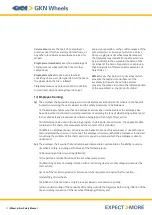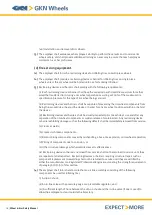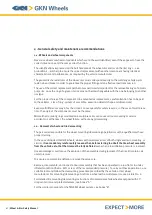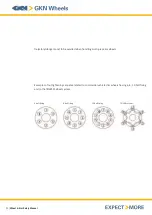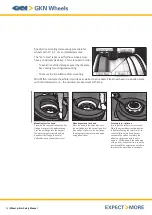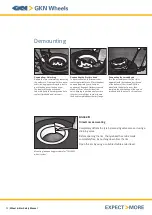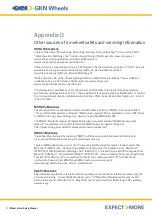
90 |
Wheel & Rim Safety Manual
Extreme care should be taken: the sudden release of the air contained in the tire can cause serious injury.
Always use an air gauge to measure the tire pressure. The correct value, specified for the tire, must be
maintained to avoid damage to tire or fracture of the wheel/rim.
2.5 - Mounting of wheel to the vehicle - studs and nuts
The tire/wheel assembly must be correctly positioned relative to the hub when mounting on the vehicle.
Be sure that: the diameter of pilot hole - diameter of stud holes - number and shape of stud holes -
wheel offset or inset - type and kind of bolts/studs and nuts correspond to the characteristics of the
vehicle axle hub.
All mounting parts such as studs, spherical or conical nuts, nuts with captive washer, special parts for
steel and light alloy wheels, must fit exactly to the wheel being mounted.
Any incorrect combination of parts (different type, different shape of radius/angle, different length) may
cause nut loosening or the wheel failure.
To prevent rusting, small amounts of oil may be applied to the wheel nut and stud threads. Care must be
taken not to over lubricate.
Studs and nuts of all disc wheels have to be fastened in accordance with the vehicle manufacturer's
instructions, either using a torque spanner or by means of a tool designed to reach the torque value
specified by the vehicle manufacturer.
As far as the recommended amount of the torque is concerned, the instructions of the vehicle producer
must be followed. The torque specified by the agricultural tractor manufacturer, must also be applied to
the bolts connecting the disc to the rim lugs, for the case of wheels having variable track.
The correct tightening sequence is crosswise for the wheel disc, that is to tighten one nut then the
opposite one or the farthest away -- see some examples in picture No. 7.
However, for the TRILEX® wheel system the correct tightening sequence is around the wheel spider, for
example tighten the adjacent nuts in a clockwise direction (i.e., do not tighten crosswise). Tighten
progressively to the final torque, not in one go.
Excessive nut tightening may cause deformation of wheel disc or of bolt/stud failure. An insufficient
tightening may cause the wheel loosening.
On a new vehicle and always after a wheel/tire replacement, it is imperative to verify the mounting torque
after approximately 50-100 km of operation and, where necessary, to re-tight the wheel nuts to the
correct value.
It is recommended to periodically check the nut torque.
Содержание Wheel & Rim
Страница 1: ...Wheel Rim Safety Manual...
Страница 74: ...73 Wheel Rim Safety Manual GKN OffHighway Wheels Products...


